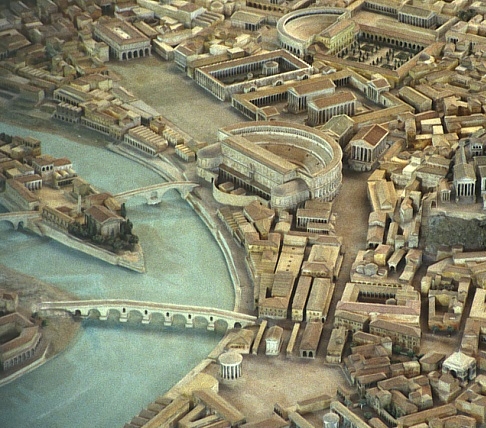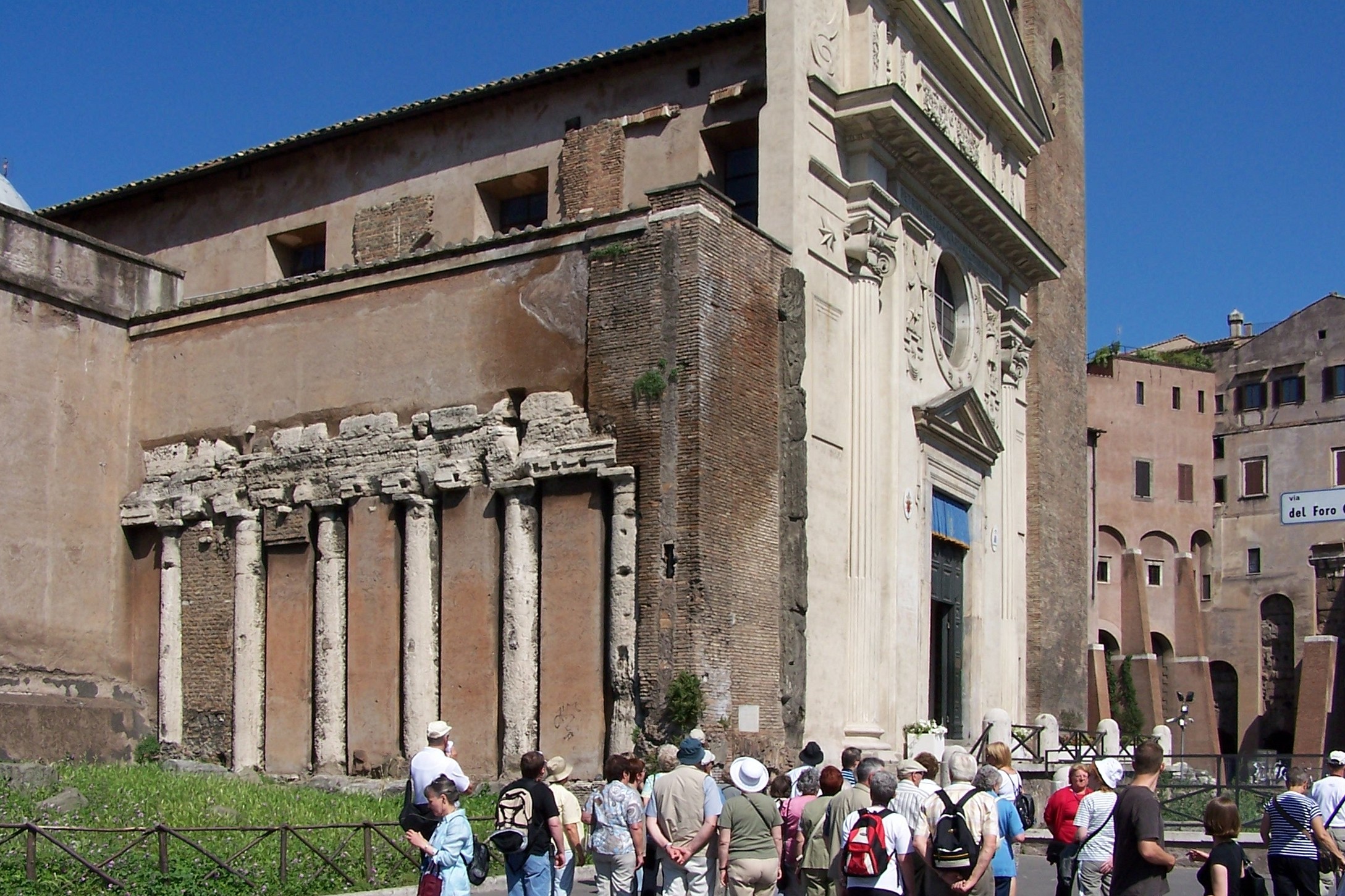Forum Holitorium on:
[Wikipedia]
[Google]
[Amazon]
The Forum Holitorium ( it, Foro Olitorio; en, Vegetable-sellers' Market) is an archaeological area of
In ancient times it was the fruit and vegetable market, while the area of the adjacent Forum Boarium served as meat market. It also included a sacred area with three small temples dedicated to Janus, Spes and Juno Sospita.
 The construction of the sacred area of the forum dates back to the Republican age, more precisely to the period between the first and the second Punic War. Subsequently, at the time of Caesar (
The construction of the sacred area of the forum dates back to the Republican age, more precisely to the period between the first and the second Punic War. Subsequently, at the time of Caesar (
These temples are now part of the structure of the Basilica of San Nicola in Carcere, whose earliest historical news date back to the 11th century in the '' Liber Pontificalis''
It was a peripteros temple ''sine postìcum'' (with columns on three sides), with eight
It was a peripteros
 The temple of Juno Sospita was located between the temple of Spes and that of Janus: on its ruins, towards the end of the 11th century, the current church was founded.
The temple of Juno Sospita was located between the temple of Spes and that of Janus: on its ruins, towards the end of the 11th century, the current church was founded.
Built around 195 BC by Gaius Cornelius Cethegus, it was a peripteros ionic temple, with six columns on the facade, three rows of columns on the front side and two on the back side. A travertine staircase, the same which is still used today to access the church, led to the pronaos of the temple. It was the largest of the three, since it measured in length and in width, as well as the tallest one, as can be seen by comparing the preserved columns of each of the temples. The present structure is due to the restoration commissioned by a certain Caecilia Metella in 90 BC. The remains of the temple are the basement, which can be visited inside the church, and three columns incorporated into the facade, one of which has no
Forum Holitorium
* {{Monuments of Rome Holitorium Rome R. XII Ripa Archaeological sites in Rome
Rome
, established_title = Founded
, established_date = 753 BC
, founder = King Romulus ( legendary)
, image_map = Map of comune of Rome (metropolitan city of Capital Rome, region Lazio, Italy).svg
, map_caption ...
, Italy, on the slopes of the Capitoline Hill
The Capitolium or Capitoline Hill ( ; it, Campidoglio ; la, Mons Capitolinus ), between the Forum and the Campus Martius, is one of the Seven Hills of Rome.
The hill was earlier known as ''Mons Saturnius'', dedicated to the god Saturn. ...
. It was "oddly located" outside the Porta Carmentalis in the Campus Martius, crowded between the Forum Boarium ("Cattle Market") and buildings located in the Circus Flaminius
The Circus Flaminius was a large, circular area in ancient Rome, located in the southern end of the Campus Martius near the Tiber River. It contained a small race-track used for obscure games, and various other buildings and monuments. It was "bu ...
.In ancient times it was the fruit and vegetable market, while the area of the adjacent Forum Boarium served as meat market. It also included a sacred area with three small temples dedicated to Janus, Spes and Juno Sospita.
The sacred area
 The construction of the sacred area of the forum dates back to the Republican age, more precisely to the period between the first and the second Punic War. Subsequently, at the time of Caesar (
The construction of the sacred area of the forum dates back to the Republican age, more precisely to the period between the first and the second Punic War. Subsequently, at the time of Caesar (1st century BC
The 1st century BC, also known as the last century BC and the last century BCE, started on the first day of 100 BC and ended on the last day of 1 BC. The AD/BC notation does not use a year zero; however, astronomical year numberi ...
), it underwent renovations which involved the demolition of a fourth temple: it was built by Manius Acilius Glabrio (consul
Consul (abbrev. ''cos.''; Latin plural ''consules'') was the title of one of the two chief magistrates of the Roman Republic, and subsequently also an important title under the Roman Empire. The title was used in other European city-states throu ...
in 191 BC) next to the Temple of Janus and was demolished during the construction of the Theatre of Marcellus (then completed by Augustus
Caesar Augustus (born Gaius Octavius; 23 September 63 BC – 19 August AD 14), also known as Octavian, was the first Roman emperor; he reigned from 27 BC until his death in AD 14. He is known for being the founder of the Roman Pr ...
). The temple was dedicated to the worship of Diana.
The staircases of the three temples were not aligned, which confirms the absence of uniform town-planning criteria during the Republican age. Their construction delimited the area of the market, which previously should have extended up to the Tiber
The Tiber ( ; it, Tevere ; la, Tiberis) is the third-longest river in Italy and the longest in Central Italy, rising in the Apennine Mountains in Emilia-Romagna and flowing through Tuscany, Umbria, and Lazio, where it is joined by th ...
.These temples are now part of the structure of the Basilica of San Nicola in Carcere, whose earliest historical news date back to the 11th century in the '' Liber Pontificalis''
Temple of Janus
The Temple of Janus was the one located on the right and the closest to the Theatre of Marcellus. Built byGaius Duilius
Gaius Duilius ( 260–231 BC) was a Roman general and statesman. As consul in 260 BC, during the First Punic War, he won Rome's first ever victory at sea by defeating the Carthaginians at the Battle of Mylae. He later served as censor in 258, a ...
at the time of the First Punic War, it was restored in AD 17 by Tiberius
Tiberius Julius Caesar Augustus (; 16 November 42 BC – 16 March AD 37) was the second Roman emperor. He reigned from AD 14 until 37, succeeding his stepfather, the first Roman emperor Augustus. Tiberius was born in Rome in 42 BC. His father ...
.It was a peripteros temple ''sine postìcum'' (with columns on three sides), with eight
tuff
Tuff is a type of rock made of volcanic ash ejected from a vent during a volcanic eruption. Following ejection and deposition, the ash is lithified into a solid rock. Rock that contains greater than 75% ash is considered tuff, while rock ...
( peperino) columns on the long sides and six on the front (hexastyle), covered with stucco and raised on a low podium with elegant shaping.
Temple of Spes
The Temple of Spes (Latin
Latin (, or , ) is a classical language belonging to the Italic languages, Italic branch of the Indo-European languages. Latin was originally a dialect spoken in the lower Tiber area (then known as Latium) around present-day Rome, but through ...
: ''Aedes Spei'') was located on the left, in opposition to the Temple of Janus. It was built by Aulus Atilius Calatinus, at the time of the First Punic War as well; it was restored in 232 BC and rebuilt after the fire of 213 BC, which also destroyed the temples of Sant'Omobono Area;See Livy, XXV, 7.5-6: «t the beginning of 212 BC
T, or t, is the twentieth letter in the Latin alphabet, used in the modern English alphabet, the alphabets of other western European languages and others worldwide. Its name in English is ''tee'' (pronounced ), plural ''tees''. It is deri ...
''two commissions of triumvirs were elected '' ..''the second to rebuild the temple of the goddess Fortuna and that of Mater Matuta, on this side of Porta Carmentalis, as well as the temple of Spes on the other side, all of which had been destroyed by fire in the previous year.''» finally it was restored in AD 17 by Germanicus Julius Caesar
Germanicus Julius Caesar (24 May 15 BC – 10 October AD 19) was an ancient Roman general, known for his campaigns in Germania. The son of Nero Claudius Drusus and Antonia the Younger, Germanicus was born into an influential branch of the pat ...
.It was a peripteros
doric Doric may refer to:
* Doric, of or relating to the Dorians of ancient Greece
** Doric Greek, the dialects of the Dorians
* Doric order, a style of ancient Greek architecture
* Doric mode, a synonym of Dorian mode
* Doric dialect (Scotland)
* Doric ...
temple with six columns on the front and eleven on the long side; the columns were made of raw travertine
Travertine ( ) is a form of terrestrial limestone deposited around mineral springs, especially hot springs. It often has a fibrous or concentric appearance and exists in white, tan, cream-colored, and even rusty varieties. It is formed by a p ...
and covered with stucco to simulate the appearance of marble. It measured in length and in width.
Six columns of the temple with their architrave
In classical architecture, an architrave (; from it, architrave "chief beam", also called an epistyle; from Greek ἐπίστυλον ''epistylon'' "door frame") is the lintel or beam that rests on the capitals of columns.
The term can a ...
still exist, incorporated in the left side of the church of San Nicola.
Temple of Juno Sospita
Built around 195 BC by Gaius Cornelius Cethegus, it was a peripteros ionic temple, with six columns on the facade, three rows of columns on the front side and two on the back side. A travertine staircase, the same which is still used today to access the church, led to the pronaos of the temple. It was the largest of the three, since it measured in length and in width, as well as the tallest one, as can be seen by comparing the preserved columns of each of the temples. The present structure is due to the restoration commissioned by a certain Caecilia Metella in 90 BC. The remains of the temple are the basement, which can be visited inside the church, and three columns incorporated into the facade, one of which has no
capital
Capital may refer to:
Common uses
* Capital city, a municipality of primary status
** List of national capital cities
* Capital letter, an upper-case letter Economics and social sciences
* Capital (economics), the durable produced goods used fo ...
; these columns were still visible in their original state before the facade was rebuilt. Other remains, such as some columns, are visible inside the church.
See also
* Forum Venalium * Forum Boarium * Forum Piscarium * VelabrumNotes
Further reading
* Filippo Coarelli, ''Roma'', Guide Archeologiche Laterza, Laterza, Rome-Bari 2012External links
*Forum Holitorium
* {{Monuments of Rome Holitorium Rome R. XII Ripa Archaeological sites in Rome